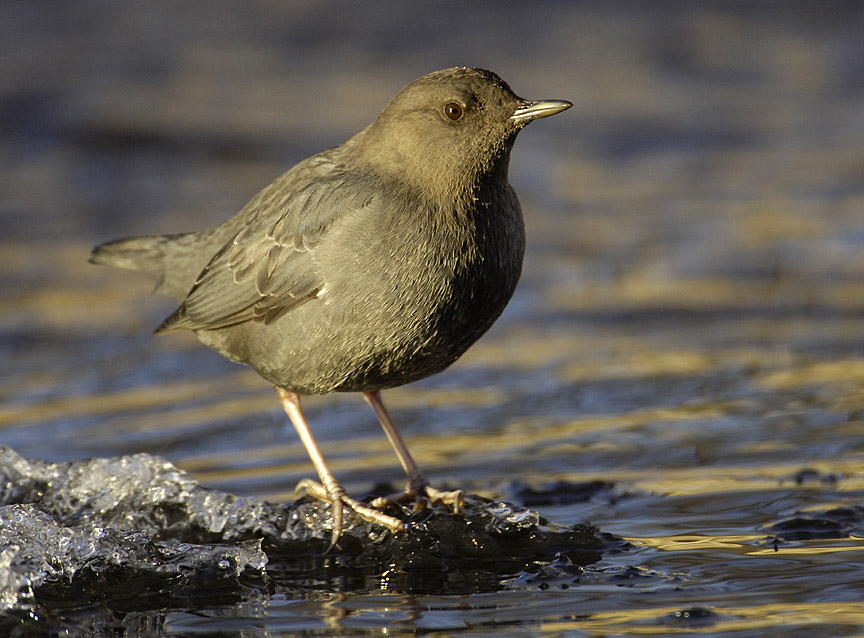American Dipper Survey Along Upper Bear Creek 2020–2021

From December 2020 through August 2021, 30 Evergreen Audubon and other community members conducted a survey for American Dippers along Bear Creek which began as a pilot study during the summer of 2019. The purpose of the expanded survey was to determine the winter distribution, abundance, and breeding status of this fascinating aquatic songbird in the Bear Creek watershed. To our knowledge, no prior comprehensive survey had been conducted along the entire creek.
The presence and successful breeding of dippers is known to be an excellent indictor of good stream health (Malone, 2014). Our survey results would provide baseline data to evaluate future changes in dipper density and productivity which could transpire due to drought, flooding, wildfires, pollution or other damaging events in the watershed should they occur.
2020-2021 American Dipper Survey
Bear Creek Breeding Bird Atlas
The Bear Creek Breeding Bird Atlas project was completed in 20818. The purpose of the Bear Creek Watershed Breeding Bird Atlas (hereafter Bear Creek Atlas) was to provide information on the distribution, abundance, breeding status and habitat use of birds on public lands within the Bear Creek Watershed.

Information from these surveys is available to the appropriate federal, state, county, and local agencies to help them manage these public lands. Data collected in this project also helps inform conservation decisions considered by Evergreen Audubon and is used for educational purposes at the Evergreen Nature Center.
Based on Evergreen Audubon’s membership and area of interest, the Bear Creek Watershed, extending from Mount Evans to the South Platte River, was designated as an appropriate area to survey breeding birds in five year increments beginning in 2008. After the initial five-year survey period, sites were continued to be surveyed every five years. These repeated surveys provide some information on how bird populations are changing within the watershed.
In general, methods followed state breeding bird atlas projects, such as the Colorado Breeding Bird Atlas. Observers recorded the numbers and breeding evidence of birds they encountered during surveys within the breeding, which is approximately 1 May–31 July. For information on this project, contact Chuck Aid.
Atlas 11-year Summary (2008-2018)
Nestbox Monitoring
In 2024 Evergreen Audubon was chosen by Jefferson County Open Space to take over all of the Open Space nestboxes in the four Open Space Parks in the Bear Creek Watershed: Elk Meadow, Alderfer Three Sisters, Flying J and Meyer Ranch. Because of our many enthusiastic volunteers, Evergreen Audubon was a perfect match for assuming monitoring of these nestboxes.

Volunteers are assigned to a team that makes bi-weekly walking visits along the nestbox trails. Visits take place throughout the spring and summer during which participants observe and record adult arrival, nest building and the number of eggs and chicks. Other cavity-nesting species may also be observed.
The monitoring data collected contributes to the growing Evergreen Audubon database of bluebird breeding success in our area and is also entered into the Cornell Laboratory of Ornithology NestWatch unified database. These data contribute to the monitoring and scientific understanding of North American breeding birds.
Systematic observation of Colorado’s migratory breeding birds provides us an opportunity to monitor variation in life cycle events, reproductive success, and changes in species distribution and abundance. Among the state’s migratory breeders are Mountain and Western Bluebirds.
In March and April, adult bluebirds return to our area from their lower elevation, more southerly winter range. Nest site selection, pair formation, breeding, egg-laying and brooding then ensue. Mountain Bluebirds depend on open grassland habitat; Western Bluebirds prefer more park-like, open forest and forest edge. Both species display a somewhat monogamous mating system, nest in tree cavities, though readily accept nest boxes, and are insectivorous during the summer breeding season. These events and behaviors may be observed in the Ponderosa Pine – Douglas Fir woodland of our Front Range.
For information about this project, contact Rachel Hutchison, Nestbox Monitoring Coordinator.
Christmas Bird Count

Each year, Evergreen Audubon members spend a December day counting all the birds they can find in a 15-mile diameter circle encompassing Evergreen and Idaho Springs.
Sponsored by the National Audubon Society, the first Christmas Bird Count was held on December 25, 1900 in Central Park, New York City, and has been going strong since that time. Information collected on Christmas Bird Counts is used to track the status of birds throughout North America and the Western Hemisphere.
Evergreen Christmas Bird Count Summaries (2007-2020)
National Audubon Christmas Bird Count Information
International Dawn Chorus

Evergreen Audubon participates in the annual International Dawn Chorus by gathering at Evergreen Lake at dawn on the first Sunday of May to count all the local birds. The event includes a Potluck Buffet Breakfast at the Evergreen Nature Center.
Great Backyard Bird Count

The Great Backyard Bird Count (GBBC) is a free, fun, and easy event that engages bird watchers of all ages in counting birds to create a real-time snapshot of bird populations. Participants are asked to count birds for as little as 15 minutes (or as long as they wish) on one or more days of the four-day event each February and report their sightings online at birdcount.org. Anyone can take part in the Great Backyard Bird Count, from beginning bird watchers to experts, and you can participate from your backyard, or anywhere in the world.
Each checklist submitted during the GBBC helps researchers at the Cornell Lab of Ornithology and the National Audubon Society learn more about how birds are doing, and how to protect them and the environment we share. Last year, more than 140,000 participants submitted their bird observations online, creating the largest instantaneous snapshot of global bird populations ever recorded.
International Migratory Bird Day

International Migratory Bird Day occurs during the second weekend of May, and is another annual event that Evergreen Audubon celebrates, though sometimes in combination with the Dawn Chorus the prior weekend.